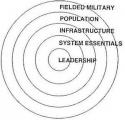Sorry Neil - my heads in academic language right now ...

Okay, fuzzy sets. Fuzzy sets allow an individual "object" to be a partial member of a set with a relative weight (from 0.0 to 1.0). This is opposed to crisp sets which only allow an object to either be or not be a member of the set.
Topologies are one way of conceiving "spaces", including perceptual spaces. A topology is defined by boundary conditions that define the membership requirements of an object or area as being within that topology. So, for example, we can define "irregular warfare" as a topology with certain boundary condition (the same for COIN, etc.).
Now, one of the two mathematical languages used to define topologies is set theory so, rather than using crisp sets, we can replace them with fuzzy sets.
Now, there are two main advantages to using this type of model:
- you can include actions (requirements, missions, etc.) that don't necessarily "fit" exactly into any definition.
- you can measure change over time of a particular "object".
Does that make it a bit clearer

?



 "A Sherman can give you a very nice... edge."- Oddball,
"A Sherman can give you a very nice... edge."- Oddball, 












Bookmarks